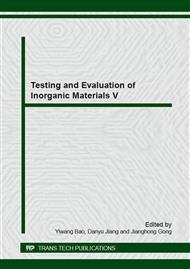p.189
p.193
p.198
p.204
p.210
p.214
p.218
p.225
p.230
Influences of Working Power on Properties for Boron Films Deposited by R. F. Magnetron Sputtering
Abstract:
Boron and boron-rich boride has attracted considerable attention in the past few years for their wide varieties of structures and property associated with their unusual three-center electron-deficient bonds. Boron film also exhibits many unique and fascinating properties, such as high melting point (~ 2500K) with low density, high harness close to diamond, and excellent thermoelectric property. In this paper, boron (10B) films were prepared on (100) silicon substrate by radio frequency (r. f.) magnetron sputtering method under the different working pressure and power with a target of boron and boron oxide (B:B2O3 40wt%). After 3 hours sputtering deposition, the substrate was covered with boron films tightly. The morphology of deposited films under different temperature was characterized by high resolution scanning electron microscopy (HRSEM), FTIR spectrum (FTIR), Raman spectrum (Raman). The results show that the film contains boron and little oxygen. At last, the growth mechanism of B film was analyzed.
Info:
Periodical:
Pages:
210-213
Citation:
Online since:
November 2014
Authors:
Keywords:
Price:
Сopyright:
© 2015 Trans Tech Publications Ltd. All Rights Reserved
Share:
Citation:


